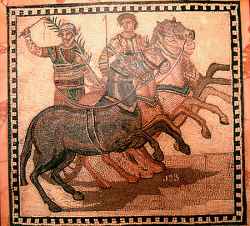 January 13th is the seventh of the 12 Days of Defiance, celebrating those who stand strong against tyranny. The first day honors St. Lucian, who resisted Pagan oppression during his nine years in prison. The sixth day honors John Hancock, Unitarian and first signer of the Declaration of Independence.
January 13th is the seventh of the 12 Days of Defiance, celebrating those who stand strong against tyranny. The first day honors St. Lucian, who resisted Pagan oppression during his nine years in prison. The sixth day honors John Hancock, Unitarian and first signer of the Declaration of Independence.
The final six days are dedicated to Nika Week, in honor of a moment of defiance in Constantinople during Christianity’s slow slide into the Dark Ages following the adoption of Trinitarianism.
This year, Nika Week begins on the Ultimate Thursday of the dozenal, an extra special occasion!
During the Byzantine Empire, there were four major factions, based not only on political and religious differences but also focused intensely upon sports teams, particularly charioteers. These factions were identified primarily by colors: Whites, Reds, Blues, and Greens.
By the time of Emperor Justinian in the 6th Century, the only factions with any influence were the Blues, who favored the Emperor and the wealthy, and the Greens, who supported the common people. Another critical distinction was that the Greens were Monophysites, meaning they believed that the human will of Jesus was absorbed in the divinity of Christ, while the Blues held to the Chalcedonian dogma being imposed on the common people from above: that Jesus was simultaneously fully human and fully divine.
In 532, both the Blues and Greens had become so dissatisfied with Justinian that they joined forces, first to demand the pardon of a Blue and a Green accused of murder. Then, during a chariot race in Constantinople’s Hippodrome, the two sides set aside their partisanship, exchanging their competing shouts of “Blue!” and “Green!” for a unified chant of “Nika! Nika! Nika!”
Nika (νίκα) is Greek for “Conquer!”
The united Blues and Greens assaulted the palace, demanding Justinian unseat unpopular appointees. Finally, from their gathering place in the Hippodrome, they declared a new Emperor, Hypatius, from among the Greens.
Fearing for his life, the Emperor nearly fled the city. Instead, however, Justinian sent a bribe of gold coins to the Blues with a reminder that the man they had chosen to replace him was a Green. After conferring among themselves, the Blues suddenly fled the Hippodrome in the middle of Hypatius’s coronation. After the Blues were gone, Imperial troops flooded in, slaughtering the Greens.
About 30 thousand were killed during the Nika Riots, which ultimately failed. After nearly a century of (not always peaceful) coexistence between Chalcedonian and Monophysite Christianity, Justinian had books that were believed to support Monophysitism condemned to force the people to submit to Chalcedonian ideology. In order to consolidate his control, Justinian forcibly detained and eventually banished Pope Vigilius, partly for his refusal to participate in the Second Nicene Council of Constantinople which affirmed absolute Imperial command over the church and its doctrines.
Still, the Nika Riots stand out as a moment of unity against tyranny that should be honored and remembered, even as we also remember the fragility of such an alliance in the face of greed, partisanship, and the lust for ecclesiocratic power.
